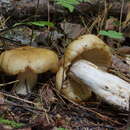Associations
provided by BioImages, the virtual fieldguide, UK
In Great Britain and/or Ireland:
Fungus / parasite
fruitbody of Asterophora parasitica parasitises moribund fruitbody of Russula foetens
Foodplant / mycorrhiza / ectomycorrhiza
fruitbody of Russula foetens is ectomycorrhizal with live root of Broadleaved trees
Remarks: Other: uncertain
Foodplant / mycorrhiza / ectomycorrhiza
fruitbody of Russula foetens is ectomycorrhizal with live root of Fagus
Remarks: Other: uncertain
Other: major host/prey
Foodplant / mycorrhiza / ectomycorrhiza
fruitbody of Russula foetens is ectomycorrhizal with live root of Quercus
Remarks: Other: uncertain
Other: major host/prey
Foodplant / mycorrhiza / ectomycorrhiza
fruitbody of Russula foetens is ectomycorrhizal with live root of Betula
Remarks: Other: uncertain
Other: minor host/prey
Foodplant / mycorrhiza / ectomycorrhiza
fruitbody of Russula foetens is ectomycorrhizal with live root of Pinus sylvestris
Remarks: Other: uncertain
Comprehensive Description
provided by North American Flora
Russula foetens (Pers.) Fries, Epicr. Myc. 359. 1838
A garicus foetens Pers. Obs. Myc. 102. 1796.
Russula foetentula Peck, Bull. N. Y. State Mus. 116: 85. 1907.
Pileus fleshy, firm, then fragile, subglobose, becoming plane to slightly depressed in the center, 7.5-12.5 cm. broad; surface honey-colored or dull-buff to reddish-brown, viscid when moist, pellicle separable part way to the disk, glabrous; margin widely striatetuberculate or stilcate, thin and incurved at first: context whitish, except next to the cuticle, where it is yellowish, acrid to slowly acrid and unpleasant, the odor at first like bitter almonds, then fetid ; lamellae white, becoming yellowish with age, reddish-brown where bruised, some short ones present, many forking next to the stipe and a few part way to the margin, interspaces venose, exuding drops of water when young, rather close, broad, narrowed toward the stipe, adnexed; stipe whitish, becoming yellowish or umber where handled or with age, stuffed to hollow, equal, 4-8 cm. long, 1.2-2.5 cm. thick: spores whitish to cream-colored, subglobose, slightly echinulate, 7-8 X 9-10 m-
TypiS locality: Europe.
Habitat: In mixed woods and bushy places.
Distribution: Maine to Alabama and west to Ohio and Michigan; also in Europe.
- bibliographic citation
- William Alphonso MurrilI, Gertrude Simmons BurIingham, Leigh H Pennington, John Hendly Barnhart. 1907-1916. (AGARICALES); POLYPORACEAE-AGARICACEAE. North American flora. vol 9. New York Botanical Garden, New York, NY
Russula foetens: Brief Summary
provided by wikipedia EN
Russula foetens, commonly known as the stinking russula, is a common Russula mushroom found in deciduous and coniferous forests.
- license
- cc-by-sa-3.0
- copyright
- Wikipedia authors and editors

